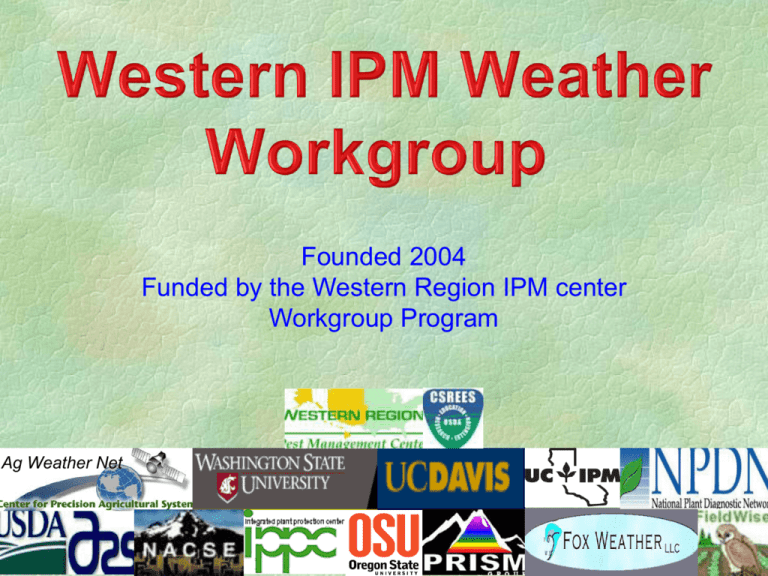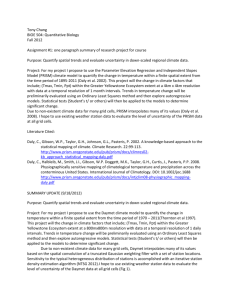Overview Western IPM Weather Workgroup
advertisement

Founded 2004 Funded by the Western Region IPM center Workgroup Program Ag Weather Net Ag Weather Net What brought us together? All have worked to develop IPM tools based on weather data All reached the same conclusion The benefits of crop, pest, and disease forecasting models are only realized if we have high quality weather and forecast data at sufficient spatial resolution. Prior collaborations among most members Ag Weather Net Current Membership Len Coop, OSU &IPPC: Pest modeling, GIS interpolation & delivery Chris Daly, OSU &PRISM Group: Spatial climate analysis Alan Fox, Fox Weather, LLC: Ag. weather modeling & forecasting Dave Gent, USDA-ARS NFSPRC: Epidemiology (hops) Gary Grove, WSU: Director WA AgWeatherNet & Epidemiology Doug Gubler, UC Davis: Epidemiology and extension (fruits & nuts) David Hannaway, OSU: Forage Crops and Extension Paul Jepson, OSU IPPC: Director IPPC; IPM and biosecurity Dennis Johnson, WSU: Epidemiology and extension (potatoes) Walt Mahaffee, USDA-ARS: Epidemiology (small fruit & nursery) Bill Pfender, USDA-ARS NFSPRC: Epidemiology (grass seed) Joyce Strand, UC IPM: Ag. meteorology and information systems Carla Thomas, UC Davis & NPDN: Epidemiology, biosecurity & IPM Ag Weather Net To develop a science-based system that provides principles and procedures to access, synthesize, distribute, and use weather and climate data products to improve crop management decision-making abilities through the delivery of weather based information. Ag Weather Net Group Philosophy/Principles IPM is local and personal. Any regional or national approach must be based on a consortium of local IPM efforts linked together with some aspects coordinated or provided at a regional or national level. Facilitating the availability of weather and climate based information will require public and private enterprises. Benefits of competition and innovation must be balanced against development of general standards that may suppress innovation. Ag Weather Net Group Philosophy/Principles Seek contributions and collaborations from outside the group Long term sustainability of a system will depend on expanding partnerships to include forestry, urban planning, recreational settings, transportation, etc. Ag Weather Net Why is the group succeeding? Diverse expertise Subject matter and career point First established common ground then developed direction Constant change in who are the dominant leaders of the group Various forms of communication that occur regularly More than one meeting a year Ag Weather Net Where are We Going? Interactive Virtual Weather Station Ag Weather Net Ag Weather Net Ag Weather Net Where are we? Virtual Weather Station 1.0 Ag Weather Net Ag Weather Net 12,500+ weather stations assimilated per day nationwide • Hourly or better from MesoWest plus several grower-run networks Deriving Weather from Climate Climatologically-Aided Interpolation (CAI) • Climatology as first guess field • Near real-time station data used to modify first guess field Downscaling • Weather maps at higher spatial resolution than climatology • Calculate local elevation regressions using finegrid DEM http://pnwpest.org/wea/indextable.html Ag Weather Net 1971-2000 Today’s PRISM Climate Anomalies Ag Weather Net Today’s Spatial Estimates Parameter-elevation Regressions on Independent Slopes Model Generates gridded estimates of climatic parameters Moving-window regression of climate vs. elevation for each grid cell Uses nearby station observations Spatial climate knowledge base weights stations in the regression function by their physiographic similarity to the target grid cell http://www.prism.oregonstate.edu/ Ag Weather Net Ag Weather Net Rain Shadow: Mean Annual Precipitation Oregon Cascades Portland Mt. Hood Eugene PRISM Station Weighting Mt. Jefferson 100 in/yr 90 in/yr Terrain orientation Sisters Terrain steepness 14 in/yr Moisture Regime Redmond Elevation 10 in/yr Bend Ag Weather Net Ag Weather Net Coastal Effects: 1971-00 July Maximum Temperature Central California Coast Sacramento Stockton San Francisco Oakland Preferred ° 34 Fremont PRISM Station Weighting Trajectories San Jose Coastal Proximity Santa Cruz Elevation ° Hollister ° 27 20 Monterey Ag Weather Net Ag Weather Net Salinas Inversion Layer N Willits 9° Ukiah 17 Cloverdale Lake Pilsbury. ° Lakeport 10 16 ° ° PRISM Station Weighting ° 12 Topographic Index 17 Ag Weather Net Ag Weather Net ° Inversion Layer Improving Resolution of Spatial Interpolation 4 km/pixel Ag Weather Net Ag Weather Net Improving Resolution of Spatial Interpolation 0.8 km/pixels Ag Weather Net Ag Weather Net Ag Weather Net Old 1961-1990 New 1971-2000 4 km 800 m MtnRT – Fox Weather, LLC Directly downscales coarse-grid forecast model output Local prediction for Rain/Temp/RH/LW, wind, at 2 km Well-developed, operational, out to 5 days for OR, WA, CA Predicts inversion heights and nocturnal cold layers Spatially accounts for terrain and Coastal effects PRISM Forecast System – OSU PRISM Group Modifies a long-term climatology with forecast model output Uses CAI (“climatological fingerprint”) In early stages of development Experimental operation for temp only, 24-hr forecasts 0.8 km resolution for NW OR Ag Weather Net 100-km forecast model grids (GFS) Station observations MtnRT Basic QC 0.8-km PRISM allday climate grid IDW Interp 0.8-km current weather grid 2-km 6-hrly forecast grid Mt1hr interp 2-km 1-hrly forecast grid Ag Weather Net Gaussian filter 0.8-km MtnRT PRISM 12-hrly forecast grid Where are we? Virtual Weather Station 1.0 Ag Weather Net Ag Weather Net Ag Weather Net Hop Powdery Mildew Ag Weather Net Powdery Mildew Risk Index 1. If >6 continuous hours > 30°C, then -20 2. 3. 4. 5. points, else; If > 2.5mm rain, then -10 points, else; If >6 continuous hours > 30°C on previous day, then no change in the index, else; If at least six continuous hours between 1627°C, then +20 points, else; If none of the above rules apply, then -10 points. A 0 to 100 index0 Ag Weather Net Comparison of actual vs estimated weather data in calculating powdery mildew index Ag Weather Net Ag Weather Net # OF SPORES X # OF INFECTIONS NIGHT & A.M. WEATHER [ RAIN ] + HEAT UNITS WITHIN – PLANT SPREAD NEW PUSTULES Ag Weather Net Ag Weather Net Realtime PRISM Targ. Clim. PRISM Ground Obs. Forecasts Static PRISM Ag Weather Net Estimation of missing data Flatliner checks – repeating values Compare extreme values with record highs and lows Spatial consistency checks Develop “bad boy” list Ag Weather Net N C N C Temperature gradient Temperature gradient Corvallis – Newport = 10.8C Corvallis – Newport = 3.8C Ag Weather Net A warm, dry weather pattern Ag Weather Net One of several cold-weather patterns Weather Research and Forecast Model WRF Next generation meso-scale forecast model (after MM5) Developed by NCAR, NOAA, Air Force, et al. Operational at 37-km for western US at Fox Weather Beta testing for use with MtnRT More accurate forecasts than 100-km GFS, especially in coastal areas Ag Weather Net MtnRT Temperatures + PRISM Targeted Climatolo gies + MtnRT Winds 30-40-km forecast model grids (WRF) Station observations MtnRT Spatial QC 4-km 3-hrly forecast grid Future IDW MtnRT- PRISM Interp 0.8-km PRISM all-day or targeted climate grid PRISM 0.8-km current weather grid Gaussian filter 0.8-km 0.8-km 3-hrly forecast grid Mt1hr interp 3-hrly forecast grid 0.8-km 1-hrly forecast grid 0.8-km Adjusted Bias 1-hrly forecast grid 0.8-km 1-hrly forecast grid Correct Ag Weather Net Public Weather Data Expected configuration Ag Weather Net Station placement not always optimal Does sensor location matter? Ag Weather Net






